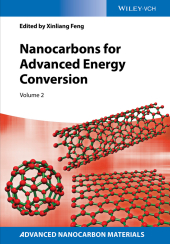 Neuerscheinungen 2015Stand: 2020-02-01 |
Schnellsuche
ISBN/Stichwort/Autor
|
Herderstraße 10
10625 Berlin
Tel.: 030 315 714 16
Fax 030 315 714 14
info@buchspektrum.de |

Xinliang Feng
Nanocarbons for Advanced Energy Conversion
Herausgegeben von Feng, Xinliang
1. Auflage. 2015. 326 S. 200 SW-Abb., 100 Farbabb. 244 mm
Verlag/Jahr: WILEY-VCH 2015
ISBN: 3-527-33666-4 (3527336664)
Neue ISBN: 978-3-527-33666-1 (9783527336661)
Preis und Lieferzeit: Bitte klicken
Divided into three major parts, this invaluable reference provides a current overview of the design, synthesis, and characterization of nanocarbons, such as carbon nanotubes, fullerenes, graphenes, and porous carbons for energy conversion applications.
In this second volume in the first book series on nanocarbons for advanced applications the highly renowned series and volume editor has put together a top author team of internationally acclaimed experts on carbon materials.
Divided into three major parts, this reference provides a current overview of the design, synthesis, and characterization of nanocarbons, such as carbon nanotubes, fullerenes, graphenes, and porous carbons for energy conversion applications. It covers such varied topics as electrocatalysts for oxygen reduction reactions in the different types of fuel cells, metal-air batteries and electrode materials for photovoltaic devices, as well as photocatalysts, electrocatalysts and photoelectrocatalysts for water splitting.
Throughout, the authors highlight the unique aspects of nanocarbon materials in these fields, with a particular focus on the physico-chemical properties which lead to enhanced device performances.
PART I. NANOCARBONS FOR ELECTROCATALYSIS
Doped Carbon Nanotubes as Electrocatalysts for Oxygen Reduction Reactions (ORR)
Doped Graphene as Electrocatalysts for Oxygen Reduction Reactions
Doped Nanoporous Carbon for Electrocatalysis
Nanocarbon-Based Hybrids for Electrocatalysis
Nanocarbon-Based Non-Precious Metal Catalysts for Oxygen Reduction Reactions
Spectroscopy Analysis of Nanocarbon-Based Non-Precious Metal Catalyst for ORR
Carbon Nanotubes as Supports for ORR Electrocatalysts
Graphene as Supports for ORR Electrocatalysts
Nanoporous Carbon as Supports for Electrocatalysts
Doped Nanocarbon as Supports for Electrocatalysts
Nanocarbon-Anchored Molecules for Electrocatalysis
Nanocarbons and Their Hybrids as Electrocatalysts for Metal-Air Batteries
Nanocarbons and Their Hybrids as Electrocatalysts for Microbial Fuel Cells
Carbon Nanotubes and Their Hybrids as Electrocatalysts for Microbial Fuel Cells
PART II. NANOCARBONS FOR SOLAR CELLS
Carbon Nanotubes and Hybrid Materials for Dye-Sensitized Solar Cells
Graphene and Hybrid Materials for Dye-Sensitized Solar Cells
Nanocarbon for Organic Solar Cells
Carbon Nanotubes and Graphene for Silicon-Based Solar Cells
Carbon Nanotubes and Graphene as Transparent Electrodes for Solar Cells
PART III. NANOCARBONS FOR WATER SPLITTING
Nanocarbon and Hybrid Materials for Photocatalytic Water Splitting
Nanostructured Carbon Nitride for Photocatalytic Water Splitting
Nanocarbon and Hybrid Materials for Electrocatalytic Water Splitting
Xinliang Feng is a full professor at the Technische Universität Dresden since 2014 and adjunct distinguished professor at the Shanghai Jiao Tong University since 2011 as well as Director for the Institute of Advanced Organic Materials. His current scientific interests include the graphene, two-dimensional nanomaterials, organic conjugated materials, and carbon-rich molecules and materials for electronic and energy-related applications.


